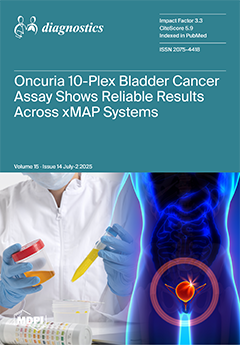Background/Objectives: For aging men experiencing lower urinary tract symptoms (LUTS), bladder diaries (BD) and uroflowmetry (UFM) are commonly used non-invasive diagnostic tools. However, bladder diaries often suffer from subjectivity and incomplete data, while traditional hospital-based uroflowmetry lacks convenience and repeatability. Therefore, there
[...] Read more.
Background/Objectives: For aging men experiencing lower urinary tract symptoms (LUTS), bladder diaries (BD) and uroflowmetry (UFM) are commonly used non-invasive diagnostic tools. However, bladder diaries often suffer from subjectivity and incomplete data, while traditional hospital-based uroflowmetry lacks convenience and repeatability. Therefore, there is a growing need for a user-friendly, artificial intelligence (AI)-powered at-home uroflow monitoring solution. This study aims to develop a novel, vibration-based home uroflowmetry system capable of recognizing uroflow curve patterns and measuring voiding parameters, and to compare its performance with other existing home-based uroflowmetry methods.
Methods: Seventy-six male participants, all of whom provided informed consent, underwent uroflowmetry to assess voiding symptoms. An accelerometer affixed to the uroflowmeter’s urine container captured vibration signals, which were used to calculate the root mean square (RMS) values and maximum amplitude (Mmax). Simultaneously, the uroflowmeter recorded standard voiding parameters and generated uroflow curves. These vibration signals were then analyzed using a convolutional neural network (CNN) to classify six distinct uroflow curve patterns, aiding in diagnostic evaluation.
Results: Seventy-six participants’ voiding volume ranged from 50 mL to 690 mL (median [Q1, Q3]: 160 [70.00, 212.50] mL). The correlation analysis revealed positive correlations between the vibration signals and voiding parameters, including the voided volume and RMS (R = 0.768,
p < 0.001), Qmax and Mmax (R = 0.684,
p < 0.001), voiding time and signal time (R = 0.838,
p < 0.001), time to Qmax and time to Mmax (R = 0.477,
p < 0.001). AI pattern recognition demonstrated high accuracy with all three indicators (precision, recall, and F1 score) surpassing 0.97.
Conclusions: This AI-assisted vibration-based home uroflowmetry enables accurate voiding parameter measurement and uroflow pattern recognition, showing high precision, recall, and F1-score. It might offer a convenient solution for continuous and subjective bladder monitoring outside clinical settings.
Full article






